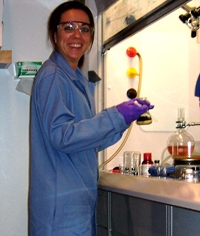
School:
Grade Level:
Teaching Position:
Supervisor:
Department:
Mentor:
Research Project Year:
Research Project Title:
Research Project Description:
The objective of the project is to develop a high performance encapsulant for solid state lighting (SSL) devices, which encompass the ever growing international need to provide energy-efficient lighting alternatives for conventionally used sources. SSL can offer many advantages over traditional fluorescent and incandescent lighting sources such as increased luminance per unit energy consumed, small size, and longer lifetime. However, there are challenges in encapsulating SSL devices in an efficient and cost effective manner, while also trying to fulfill these high performance requirements/capabilities. These encapsulent materials need to be transparent, flexible, and tough. They also need to be impermeable to oxygen and water vapor and both hydrothermal and UV-stable. The developed materials are evaluated by using Differential Scanning Calorimetry (DSC), Thermal Gravimetric Analysis (TGA), Dynamic Mechanical Analysis (DMA), Nuclear Magnetic Resonance (NMR), and UV-Vis.
Curriculum Project Year:
Curriculum Project Title:
Curriculum Project Description:
How does Frito Lay calculate the number of Calories in a Cheez Doodles? How much citric acid is in your 7UP Have you ever stopped to think about whats actually in the food you eat? The focus of my curriculum project is to create engaging, inquisitive, and investigative lessons that connect the basic chemistry standards to exciting real-world applications. Students will discover the hidden science behind everyday food and nutrition; making the connection from the classroom to the outside world.
Curriculum Project Attachments:
| Attachment | Size |
|---|---|
| 14.18 MB | |
| 1.25 MB |
